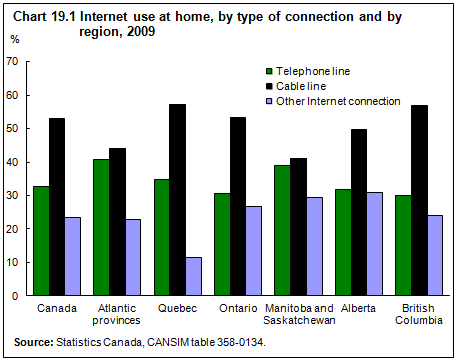Information and communications technology
Archived Content
Information identified as archived is provided for reference, research or recordkeeping purposes. It is not subject to the Government of Canada Web Standards and has not been altered or updated since it was archived. Please "contact us" to request a format other than those available.
Related information
Internet use continues to increase among Canadians. In 2009, 80% of people aged 16 and older used the Internet for personal reasons at some point during the year. By comparison, 73% of Canadians aged 16 and older went online for personal reasons in 2007.
People in British Columbia and Alberta had the highest rates of Internet use among the provinces, at 85%. Rates were lowest in Newfoundland and Labrador, at 69%.
Among large urban centres, the highest rates of Internet use were reported in Calgary and Saskatoon, at 89%. Edmonton, Ottawa–Gatineau, Vancouver and Victoria each had rates of Internet use at or above 85%.
The majority of Canadian users (96%) are accessing the Internet from home; however, a growing number are going online from work and school. In 2009, 42% of Canadian Internet users went online from work, 21% from school and 15% from a public library.
More high-speed connections
In 2009, 92% of home Internet users had a high-speed connection, an increase from 88% in 2007. High-speed connections are provided by Digital Subscriber Line (DSL), cable modem or satellite connections. High-speed connectivity is considered an important channel for delivering services to the public, and governments are expanding high-speed availability, particularly in rural areas.
Canada ranked seventh in terms of household broadband adoption among Organisation for Economic Co-operation and Development countries in 2008. However, some unevenness remains. Among home users living in communities with a population of 10,000 or more in 2009, 94% accessed the Internet through a high-speed connection, compared with 82% of those living in communities of less than 10,000 people.
Digital divide narrowing
Internet use has become more widespread. From 2007 to 2009, the gap in the rate of Internet use on the basis of income, education and age narrowed.
In 2009, 94% of people in the top 25% of household income used the Internet at some point during the year, compared with 90% in 2007. Among people in the lowest quarter of household income, 56% used the Internet, compared with 48% in 2007.
In 2009, 89% of people with at least some postsecondary education used the Internet, compared with 84% in 2007. Among people with no postsecondary education, 66% used the Internet in 2009, compared with 58% in 2007.
Older people are increasingly moving online. Canadians aged 45 and older have accounted for 60% of all new Internet users since 2007. In 2009, 98% of people aged 16 to 24 went online, a slight increase from 2007. By comparison, 66% of people aged 45 and older went online in 2009, an increase of 10 percentage points from 2007.
A similar proportion of men (81%) and women (80%) used the Internet in 2009.
E-mail most popular
In 2009, 93% of Internet users reported using e-mail from home. General browsing for fun or leisure was the second-most popular online activity with 78% of home Internet users doing so.
Online transactions increased in 2009, as 50% of home users reported ordering goods or services over the Internet and 67% went online for electronic banking or bill payment.
Downloading and posting information
In 2009, 31% of home Internet users reported downloading or watching TV or movies, while 27% reported contributing content by writing blogs, posting photographs or joining discussion groups. Rates for these activities varied with characteristics such as age and sex. Among home users aged 30 and younger, 53% went online to download or watch TV or movies, while 45% reported contributing content.
Among home Internet users, 74% of women used the Internet to search for information about health or medical conditions, compared with 66% of men. Meanwhile, 35% of men used the Internet to research investments, compared with 20% of women.
The proportion of Canadian Internet users who searched for government information online rose from 51% in 2007 to 57% in 2009.
- Date modified:

